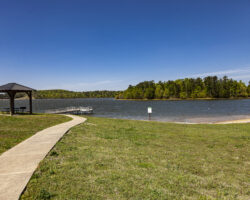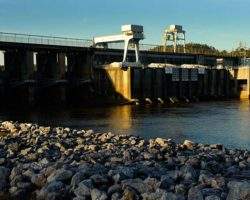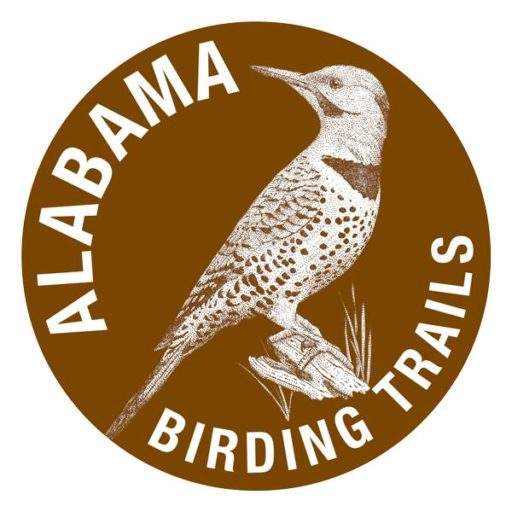Appalachian Highlands | St. Clair | Best Seasons: Fall | Spring | Winter
Ten Islands Historical Park, situated on the shores of Neely Henry Lake just above Neely Henry Dam, is a site you must explore if you’re in the vicinity. Begin with the paved entrance road, which offers numerous pullout opportunities. Stop and scan the open water to the east, where in winter you may find gulls and rafts of diving ducks, some loons (look for Pacific), grebes (watch for Eared or Red-necked), geese, and the occasional soaring Bald Eagle. Swallows, Chimney Swifts, and Purple Martins zip over the water in the warmer months.
There are a number of different habitats on the west side of the entrance road to Ten Islands Historical Park. Begin with early second-growth brush – saplings and pines. Expect Field Sparrows, Eastern Towhees, and their ilk throughout the year. By late March, White-eyed Vireos, Gray Catbirds, Prairie Warblers, Yellowbreasted Chats, Indigo Buntings, and Common Yellowthroats arrive. The west side of the road should prove productive for Tennessee, Palm, and Orange-crowned warblers in spring and fall migration. The latter two species are rare here in winter. The entrance road is also an excellent spot for Chuck-will’s-widows and Whip-poor-wills. Eastern Screech-Owls are also found in the older, more dense woods to the northwest.
Halfway to the park itself is a pullout and a trail that proceeds a short distance through second-growth habitat. This is a good place to look for Blue-winged Warblers, along with Prairie Warblers, and White-eyed Vireos from late March to September. The same trail is worth exploring for sparrows and wrens in winter. The older pines to the west and northwest — as the road winds toward the main portion of the park — have resident Brown-headed Nuthatches and Pine Warblers. Look for Worm-eating Warblers from April to October. The entire length of the entrance road has numerous Eastern Bluebirds and American Goldfinches. Cedar Waxwings may occasionally nest in the trees along the road. Barred and Great Horned Owls are local breeders here.
Ten Islands Historical Park was set aside to commemorate a little known Civil War skirmish. There is a historical marker describing the event adjacent to an observation platform that overlooks the developed portion of the park. Use the platform to scan the skies for soaring birds. Bald Eagles and Ospreys both nest nearby, as do Red-tailed, Red-shouldered, Broad-winged, and Cooper’s Hawks. Sharp-shinned Hawks are regulars from fall to spring. Mississippi Kites are seen, rarely, in the vicinity in late summer and early fall. Falcons – Kestrel, Merlin, and Peregrine — may appear at any time during spring and fall migration.
From the main parking lot at the lake’s edge, there is a wooden deck that offers a great perspective to scan the lake for waterfowl, eagles, and Osprey. The parking lot area also has restrooms, picnic tables (some covered,) and juncos (in winter.) The brushy areas between the picnic tables and the water should be excellent for sparrows, wrens, and even migrant warblers.
A well-maintained trail proceeds from the northwest portion of the parking area to follow a finger of the lake. There are mature mixed hardwoods bordering the south side of the trail. This is the most secluded portion of a quiet park, and you may find Wood Ducks in the backwaters here. Herons and egrets, which may be present anywhere along the shoreline, may be most approachable here. Expect Winter Wrens along the shoreline and in the rip-rap from October to April. The forest should house a broad range of woodpeckers, including Pileated and Hairy. In season there may be Red-eyed, Yellow-throated, and even Blue-headed Vireos, along with Black-and-white Warblers, Summer Tanagers, Great Crested Flycatchers, and Eastern Wood Pewees, among others.
GPS: 33.7841618 -86.065803
Ten Islands Historical Park
16157 AL 144
Ragland, AL 35131
205-472-0481
Site Accessibility
This is an accessible site with some manageable trails and a large parking area and boat ramp. There are accessible restrooms, picnic tables and a large parking area by the boat ramp with ample opportunities to scan the lake and the nearby treeline. The road is also an excellent place to watch and listen for birds.
From Neely Henry Dam in St. Clair County, proceed west on AL 144 across the dam and take the first right turn onto the unnamed entrance road to the park. The road winds through good birding habitat and dead-ends at a parking lot on the edge of the lake. Restrooms are available here in the warmer months. There are a handful of covered picnic tables.
Amenities Available: Boat Launch, Gravel or Dirt Trails, Paved Trails, Picnic Tables, Restrooms, Wheelchair Accessible
Nearby Sites

Horse Pens 40
The boulder fields of Horse Pens 40 are a fascinating place to visit, at any time of year. The best times for birding are surely during spring and fall migration, when the elevation of the site turns the mountain into a notable migrant trap. The ridg …

Logan Martin Dam
Logan Martin Dam is notable for being one of the premier locations in the state for viewing wading birds, particularly Black-crowned Night Herons. Waders in large numbers are attracted to the rough water just below the dam, where an abundance of fish …

Neely Henry Dam
Neely Henry Dam on the Coosa River offers great opportunities to observe a variety of water-loving birds. Winter brings gulls (mostly Ring-billed, some Bonaparte’s and Herring, rarely Glaucous, Lesser Black-backed, etc.) and a few Forster’s Terns, pr …
